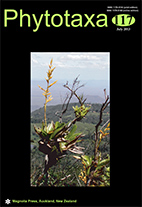Abstract
Judd (1998) formally transferred the species considered to be members of Heterosmilax Kunth (1850: 270; Koyama 1960, 1978, 1984) including Pesudosmilax Kunth (1850: 270) and Oligosmilax Seemann (1868: 258) into Smilax Linnaeus (1753: 1028) as a section, since “the segregation of these two genera would result in a paraphyletic Smilax sensu stricto because no apomorphies are known that would unite the remaining members of the group, which are characterized by flowers with free tepals and six more or less distinct stamens” (Judd 1998, p. 156). This proposal was further supported by recent molecular phylogenetic evidence (Cameron & Fu, 2006; Li et al. 2011, Qi et al. 2012), which shows that Heterosmilax distributed in Eastern and Southeast Asia is monophyletic and embedded within Smilax. The preparation of the treatment of Smilacaceae for the Flora of the Pan-Himalaya necessitates transfer of all species of Heterosmilax to Smilax. Nine new combinations are made, a new name is given and three names are resurrected.

